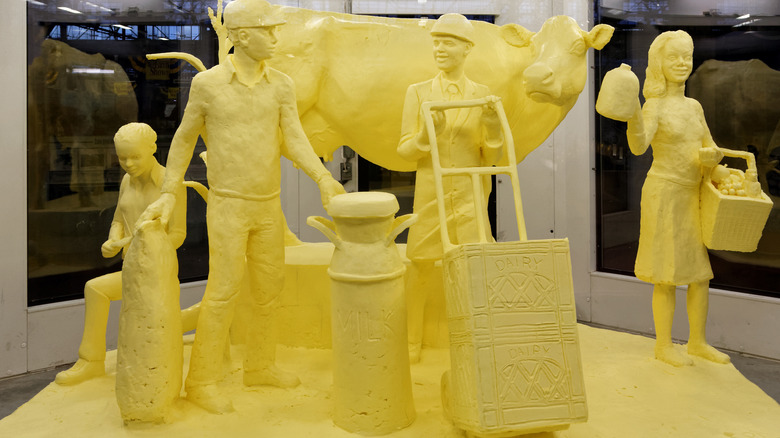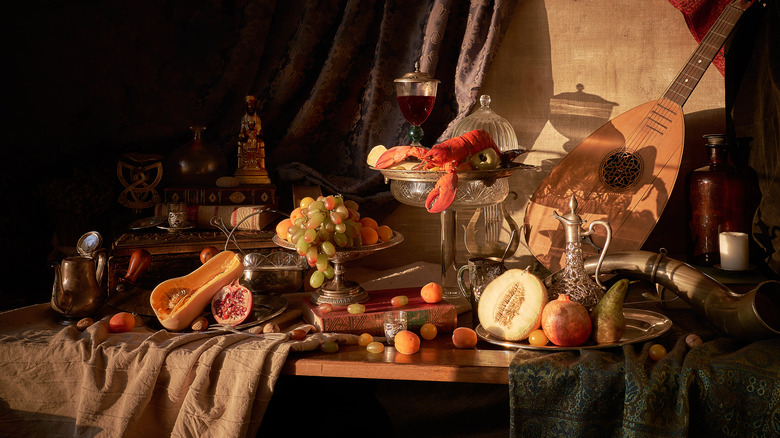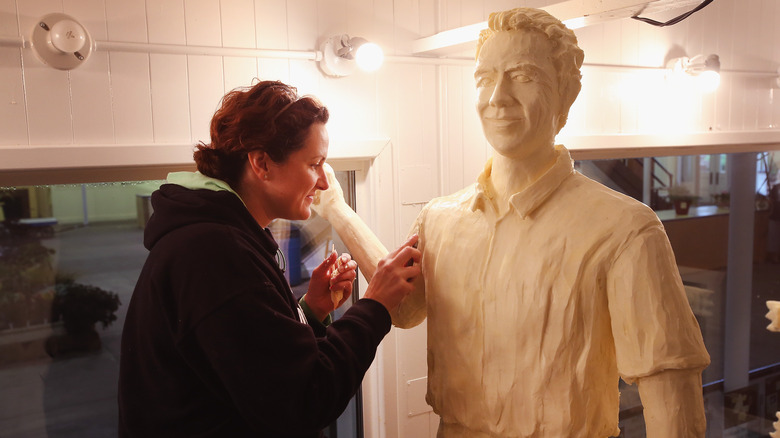The Art Of Butter Sculptures Dates Back To Medieval Times
Butter sculpting is an acquired taste — you either find it completely strange or quaintly beautiful. But no matter what you feel, most admit it takes some serious skill (and very cold hands) to pull off. While Michelangelo chose the medium of marble, a select few Americans opt for butter, sculpting golden dairy into detailed landscapes and idyllic scenes. How? Today, most make their detailed art by first creating metal molds, and then coating them with layers of butter. After it chills and sets, they can chisel in the fine details, like an arched eyebrow or the fine weaving of a basket's exterior.
Long associated with Midwest state fairs and world expositions hosted in the American heartland, butter sculptures stand as an important symbol of the rich bounty of American agriculture. Still, this folksy American tradition has roots in a much older time and place. Though it first made its Stateside debut in the late 1800s, this edible sculpture tradition dates back almost 1,000 years ago, to the medieval period of feudal kingdoms, chivalric knights, and extravagant castle feasts. So what were these delicious forefathers to butter sculptures like?
An extravagant and medieval origin story
Our tasty tale starts in the 11th century in the sumptuous dining halls of Middle Eastern palaces. Sultans and caliphs served feasts that centered around spun sugar sculptures, sweet marvels that could appear as miniatures of a palace, fantastical animals, and even a coat of arms. Also known as "subtleties," these delicate and edible sculptures spread to Europe with the trade of sugar, arriving in medieval courts of France by the 13th century. Soon, these sugar sculptures became more than a beautiful novelty. They became representative of a family or person's wealth and prestige.
It acts as one of the many heartbreaking paradoxes of the medieval era; while the elite classes dined on sugar so often that their teeth began to rot, the poor serfs who tilled the land that afforded such luxury dealt with starvation on a daily basis. Unsurprisingly, sugar subtleties' popularity fell off in the 18th century, as the increased production of it, thanks to the exploitation of enslaved people, caused prices for sugar to dip, making it more readily available for the lower classes. Pastry and ice sculptures also fall into this medieval food sculpture category, yet it has carried over to the modern era. But how did these sugar, ice, and pastry sculptures eventually morph into the Americana classic that is butter sculptures?
A 20th-century art form
One woman, Caroline Brooks, put butter sculpting on the map in the late 1800s. First developed to make her butter stand out at farmers' markets, Brooks' butter designs took on a life of their own when she began traveling from expo to expo with her crowning achievement "Dreaming Iolanthe," a butter figure that called to mind Neo-classism rather than hokey folk art.
Like their sugary medieval predecessors, butter sculptures began to represent a point of pride for those who displayed them. But instead of working as a symbol of class hierarchies, it has a hint of national patriotism, a kind of rah-rah celebration of America's agricultural prowess. This is mirrored in the career arc of the woman who first put it on the map, Brooks. Brooks moved to Washington D.C. where she became a popular member of the Republican party, commissioned to create butter busts of American presidents, socialites, and novelists.
With the birth of refrigeration in the early 20th century, butter sculpting hit its renaissance era. It maintained a place as a charming nod to American agricultural dominance up until the Great Depression when butter again became a luxury item. It's taken on yet another role today, both as an advertising vehicle for different dairies and creameries and as a bit of novelty flair for American state fairs. No matter what it means to you, you can thank the medieval food sculptures of yesteryear for inspiring this carved-butter offshoot.


